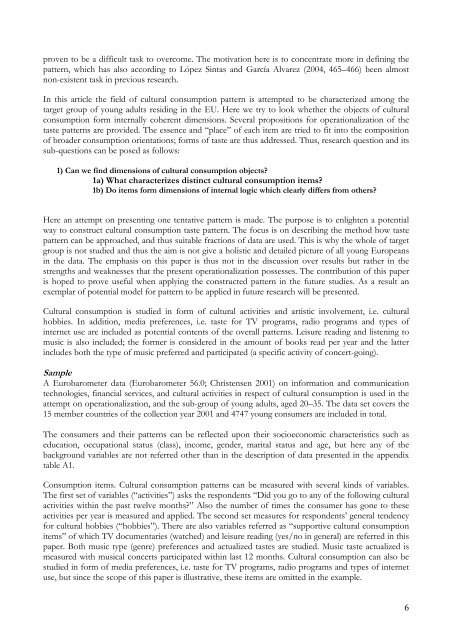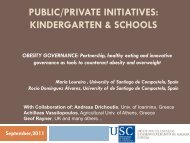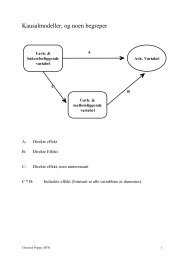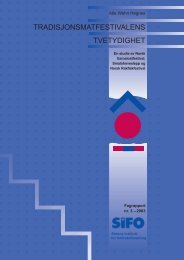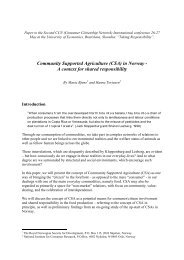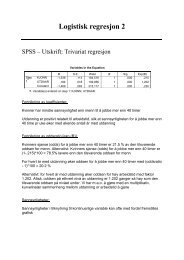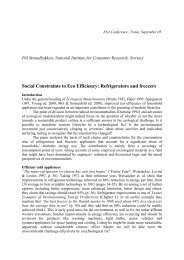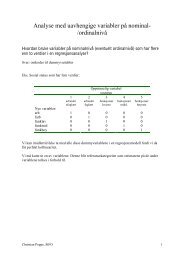Dimensions of Taste for Cultural Consumptionâ An Exemplar ... - SIFO
Dimensions of Taste for Cultural Consumptionâ An Exemplar ... - SIFO
Dimensions of Taste for Cultural Consumptionâ An Exemplar ... - SIFO
You also want an ePaper? Increase the reach of your titles
YUMPU automatically turns print PDFs into web optimized ePapers that Google loves.
proven to be a difficult task to overcome. The motivation here is to concentrate more in defining thepattern, which has also according to López Sintas and García Alvarez (2004, 465–466) been almostnon-existent task in previous research.In this article the field <strong>of</strong> cultural consumption pattern is attempted to be characterized among thetarget group <strong>of</strong> young adults residing in the EU. Here we try to look whether the objects <strong>of</strong> culturalconsumption <strong>for</strong>m internally coherent dimensions. Several propositions <strong>for</strong> operationalization <strong>of</strong> thetaste patterns are provided. The essence and “place” <strong>of</strong> each item are tried to fit into the composition<strong>of</strong> broader consumption orientations; <strong>for</strong>ms <strong>of</strong> taste are thus addressed. Thus, research question and itssub-questions can be posed as follows:1) Can we find dimensions <strong>of</strong> cultural consumption objects?1a) What characterizes distinct cultural consumption items?1b) Do items <strong>for</strong>m dimensions <strong>of</strong> internal logic which clearly differs from others?Here an attempt on presenting one tentative pattern is made. The purpose is to enlighten a potentialway to construct cultural consumption taste pattern. The focus is on describing the method how tastepattern can be approached, and thus suitable fractions <strong>of</strong> data are used. This is why the whole <strong>of</strong> targetgroup is not studied and thus the aim is not give a holistic and detailed picture <strong>of</strong> all young Europeansin the data. The emphasis on this paper is thus not in the discussion over results but rather in thestrengths and weaknesses that the present operationalization possesses. The contribution <strong>of</strong> this paperis hoped to prove useful when applying the constructed pattern in the future studies. As a result anexemplar <strong>of</strong> potential model <strong>for</strong> pattern to be applied in future research will be presented.<strong>Cultural</strong> consumption is studied in <strong>for</strong>m <strong>of</strong> cultural activities and artistic involvement, i.e. culturalhobbies. In addition, media preferences, i.e. taste <strong>for</strong> TV programs, radio programs and types <strong>of</strong>internet use are included as potential contents <strong>of</strong> the overall patterns. Leisure reading and listening tomusic is also included; the <strong>for</strong>mer is considered in the amount <strong>of</strong> books read per year and the latterincludes both the type <strong>of</strong> music preferred and participated (a specific activity <strong>of</strong> concert-going).SampleA Eurobarometer data (Eurobarometer 56.0; Christensen 2001) on in<strong>for</strong>mation and communicationtechnologies, financial services, and cultural activities in respect <strong>of</strong> cultural consumption is used in theattempt on operationalization, and the sub-group <strong>of</strong> young adults, aged 20–35. The data set covers the15 member countries <strong>of</strong> the collection year 2001 and 4747 young consumers are included in total.The consumers and their patterns can be reflected upon their socioeconomic characteristics such aseducation, occupational status (class), income, gender, marital status and age, but here any <strong>of</strong> thebackground variables are not referred other than in the description <strong>of</strong> data presented in the appendixtable A1.Consumption items. <strong>Cultural</strong> consumption patterns can be measured with several kinds <strong>of</strong> variables.The first set <strong>of</strong> variables (“activities”) asks the respondents “Did you go to any <strong>of</strong> the following culturalactivities within the past twelve months?” Also the number <strong>of</strong> times the consumer has gone to theseactivities per year is measured and applied. The second set measures <strong>for</strong> respondents’ general tendency<strong>for</strong> cultural hobbies (“hobbies”). There are also variables referred as “supportive cultural consumptionitems” <strong>of</strong> which TV documentaries (watched) and leisure reading (yes/no in general) are referred in thispaper. Both music type (genre) preferences and actualized tastes are studied. Music taste actualized ismeasured with musical concerts participated within last 12 months. <strong>Cultural</strong> consumption can also bestudied in <strong>for</strong>m <strong>of</strong> media preferences, i.e. taste <strong>for</strong> TV programs, radio programs and types <strong>of</strong> internetuse, but since the scope <strong>of</strong> this paper is illustrative, these items are omitted in the example.6


